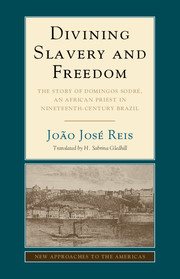 Divining Slavery and Freedom
Divining Slavery and Freedom Published online by Cambridge University Press: 05 May 2015
CANDOMBLÉ BETWEEN TOLERANCE AND REPRESSION
The day before Christmas Eve, 1858, a group of African freedpersons (i.e., ex-slaves) gathered for a batuque, the general expression then used for an African drumming session, in the Cruz do Cosme neigh-borhood on the outskirts of Salvador. Suddenly, the police surrounded and invaded the house, arresting people and seizing objects pertaining to Candomblé ceremonies. This raid caused a rift between the local subdelegado, or deputy chief constable, and the chief of police. In an official letter to his superior, subdelegado Manoel Nunes de Faria complained that he had not been informed of that police action. He later found out that the group of Africans had been arrested “for being found drumming.” He questioned that charge, and protested:
First, for your information, there was no such batuque, of which I am very well aware, and the Africans were at work, and this is nothing more than harassment, and if you perchance should pass by one afternoon and see the work of these Africans you would be amazed, and would even want to ensure that they stay in this parish, therefore it is precisely in light of this persecution that you should have them released and if you do so you will be doing them a great justice.
He went on to state that the lieutenant commander of the urban police had acted “as if there were no subdelegado in the parish, which is highly astonishing” and described the raid as typical “absolutism,” indicating a lack of confidence in his authority. If the chief of police did not trust the subdelegado, “it would only be just to fire him,” the aggrieved officer concluded.
To provide a better understanding of this controversial issue and others that would arise later, I should say something about the structure of the police service in Bahia at the time.
To save this book to your Kindle, first ensure [email protected] is added to your Approved Personal Document E-mail List under your Personal Document Settings on the Manage Your Content and Devices page of your Amazon account. Then enter the ‘name’ part of your Kindle email address below. Find out more about saving to your Kindle.
Note you can select to save to either the @free.kindle.com or @kindle.com variations. ‘@free.kindle.com’ emails are free but can only be saved to your device when it is connected to wi-fi. ‘@kindle.com’ emails can be delivered even when you are not connected to wi-fi, but note that service fees apply.
Find out more about the Kindle Personal Document Service.
To save content items to your account, please confirm that you agree to abide by our usage policies. If this is the first time you use this feature, you will be asked to authorise Cambridge Core to connect with your account. Find out more about saving content to Dropbox.
To save content items to your account, please confirm that you agree to abide by our usage policies. If this is the first time you use this feature, you will be asked to authorise Cambridge Core to connect with your account. Find out more about saving content to Google Drive.